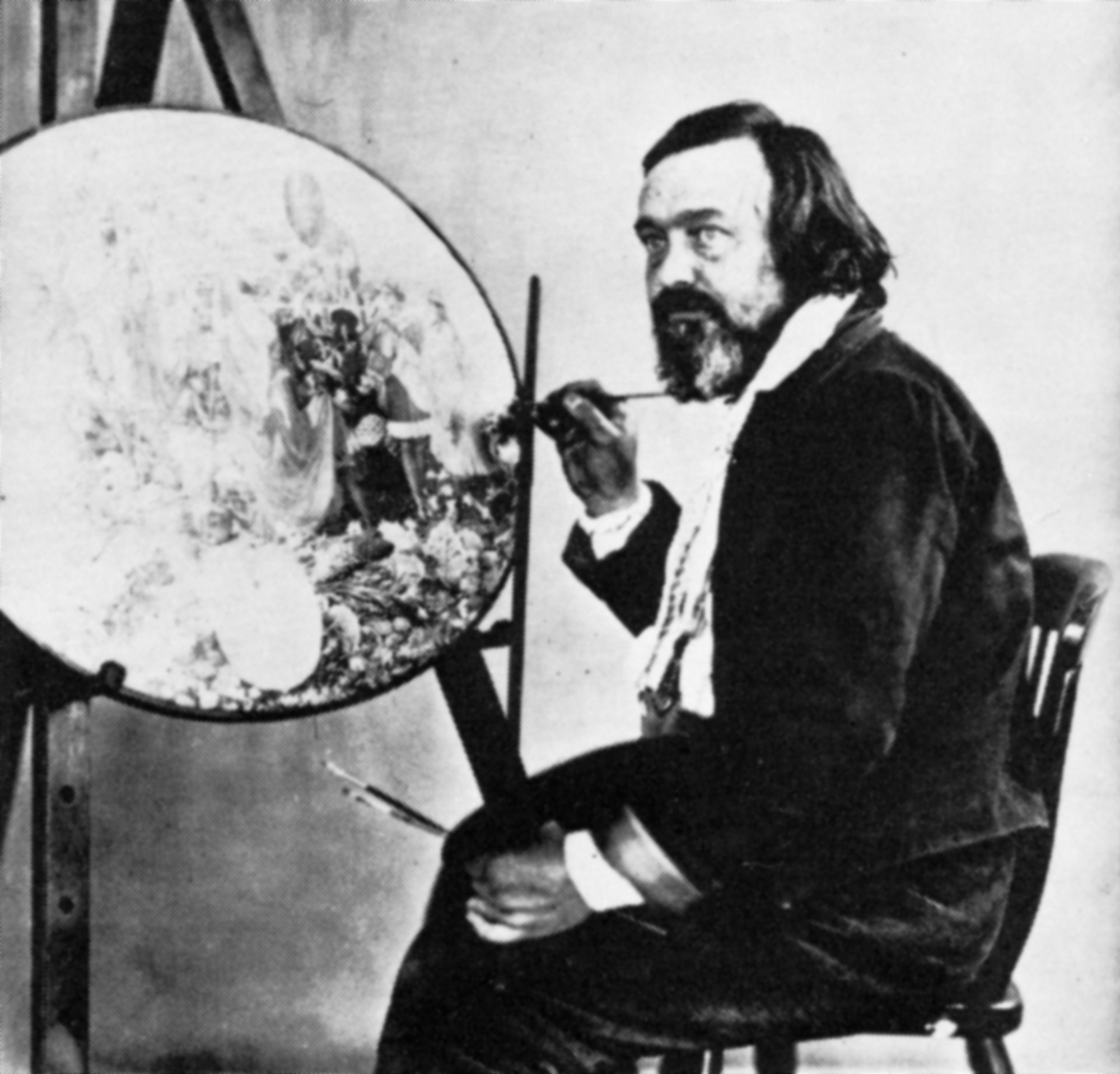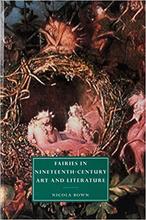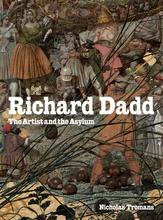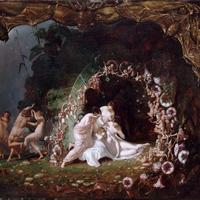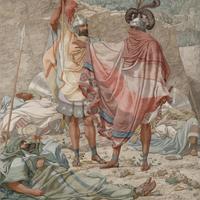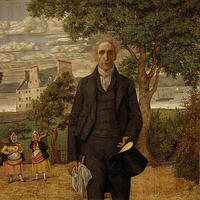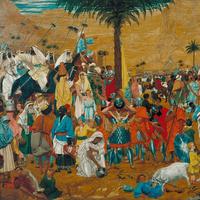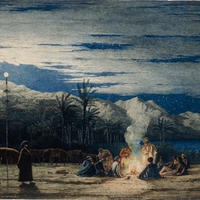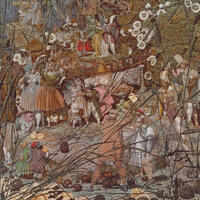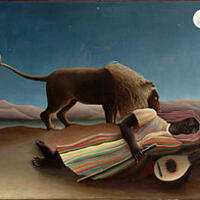More about Richard Dadd
- All
- Info
- Shop

Contributor
For most of his life, Richard Dadd had no audience or patrons and painted his fairlyland creatures in total isolation.
The fourth of nine children to a pharmacist in Kent, young Dadd was a leading light of his generation in the UK, and widely liked for his gentle intelligence and good nature. Unfortunately for Dadd, his life took a major unexpected twist when he decided to join up as a draftsman on a challenging 10-month grand tour of Europe and the Middle East.
Without frequent flyer miles, they proceeded by carriage, boat, mule, and foot from England to Belgium, Germany, Greece, and onwards to Cyprus, Syria, Palestine, Egypt, down and back up the Nile to Thebes by boat, and then back to the England through Malta and Italy. Somewhere in Egypt the god of the afterlife Osiris took control of Dadd. He developed a raging anger towards religious liberals, like his friends and his own father. Increasingly belligerent, his travel companions diagnosed him as suffering from sunstroke. Then in Rome. he attended a public ceremony presided over by the Pope, and just barely fought off an ‘uncontrollable urge’ to kill him.
Dadd returned from this journey, age 25, with his Osiris delusion in full force. At Osiris’ order he stabbed his father to death as they walked together through a park. He fled to France but was apprehended when he tried to do a Frenchman with a razor. Now properly diagnosed as ‘insane’ (more recently as paranoid schizophrenic), he wisely spent his remaining 42 years in Britain's notorious psychiatric prisons Bethlem and Broadmore. The voyage may have been a trigger for his madness, but two of his siblings suffered similarly so it was probably genetic.
Bethlem and Broadmore aren’t exactly artistic havens and Dadd’s schizophrenia did not let up. Despite the institutions’ iffy reputations, Dadd did enjoy the support of some of his jailers and, against some tough odds, produced a large number of highly detailed masterpieces.

Contributor
The medical cause of schizophrenia is still unknown to doctors, and it was even less known in the days of Charles Dickens and the schizophrenic artist Richard Dadd.
Even using the term "schizophrenic" to refer to Dadd is somewhat of a speculation, given that medicine of the time was much more interested in topics which today's doctors consider to be pseudoscientific. But it puts Dadd in a special category with the likes of Yayoi Kusama and other artists whose work thrived in confinement, which gave them discipline, material support, and, often, companionship. Posthumously, Dadd became a celebrity of the anti-psychiatry movement, even inspiring Freddie Mercury to write a song about him. Dadd's work is like Queen's music: genre-bending, full of fabulation, elaboration, humor, color, fanciful and obscure references.
In the case of an artist like Vermeer, it is challenging to write a biography because there is so little information. Dadd is at the other extreme: not only is it impossible to avoid discussing his biography along with his work, but his biography is so grotesque and shocking that it threatens to overcode any consideration of his artistic brilliance. A 1970 medical journal article searches for "signs of psychosis" within Dadd's paintings themselves, which is truly embarrassing to the discipline of psychiatry but also reveals how little the field had changed over the previous century.
The fact that Dadd committed the crime of Oedipus, brutally assaulted a random person on a train, and spent the rest of his life painting great artworks, shows that it could have been much worse for him; there is little chance that he would have avoided prison or worse in the U.S. or nearly anywhere else. On the other hand, the doctor's reports give evidence that Dadd's sister and two brothers also suffered from psychotic conditions, which indicates that although Dadd was fully aware of the gravity of his crimes, there was something chemically wrong with his head.
Sources
- Allderedge, Patricia H. "Richard Dadd (1817–1886): Painter and Patient." Medical History 14, Iss. 3 (Jul. 1970): 308-313.
- Boyce, Niall. "Richard Dadd—painting from his mind's eye." The Lancet 377, Iss. 9762 (Jan. 2011): 289 ff., https://doi.org/10.1016/S0140-6736(11)60065-2.
- Davidson, Jonathan. "Richard Dadd and the Fairy Feller’s Master-Stroke." American Journal of Psychiatry 172, Iss. 11 (Nov. 2015): 1073-1074.
- Hofmeyr, J.M. "The use of haloperidol as a long-acting neuroleptic in game capture operations." Journal of the South African Veterinary Association 52, no. 4 (1981): 273-282.
- Park, M.P., and R.H.R. Park. "The fine art of patient-doctor relationships." British Medical Journal 329, no. 7480 (Dec 2004): 1475–1480.
- Stock, Karen. "Richard Dadd’s Passions and the Treatment of Insanity." 19: Interdisciplinary Studies in the Long Nineteenth Century 23 (2016): p. None. http://doi.org/10.16995/ntn.765.
- Wise, Sarah. "Richard Dadd: freedom behind bars." The Lancet 377, Iss. 9762 (Jan 2011): 289 ff., https://www.thelancet.com/journals/lancet/article/PIIS0140-6736(15)6123….
Featured Content
Here is what Wikipedia says about Richard Dadd
Richard Dadd (1 August 1817 – 7 January 1886) was an English painter of the Victorian era, noted for his depictions of fairies and other supernatural subjects, Orientalist scenes, and enigmatic genre scenes, rendered with obsessively minuscule detail. Most of the works for which he is best known were created while he was a patient in Bethlem and Broadmoor hospitals.
Check out the full Wikipedia article about Richard Dadd

